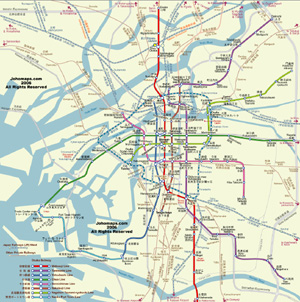|
|
Osaka | Japan |
Local
News |
Weather
| Kansai Airport
| Itami Airport |
|
Maps of Osaka |
|
Click to see the full-sized map
|
||||
| Metro Map of Osaka | ||||
| Date: | Nov, 2012 (6th Ed) | |||
| Map format: | jpeg | |||
| Dimension: | 1092 x 1100 pixels (1.12 mb) | |||
| Copyright holder: | Johomaps | |||
| Conditions of using this map: | All rights reserved | |||
| Computer Specifics: | Prepared using Adobe Illustrator | |||
|
|
||||
|
Real Time Osaka Travel Info |
||||
|
City Info |
| Other names of Osaka: Osaka-fu (Municipality of Osaka) Dialing Code: 81-6 Adjective: various Osaka (From Wikipedia) Osaka (大阪市, Ōsaka-shi) is the capital of Osaka Prefecture and the third-largest city in Japan, with a population of 2.7 million. It is located in the Kansai region of the main island of Honshu, at the mouth of the Yodo River on Osaka Bay. Osaka is the historical commercial capital of Japan and is still one of Japan's major industrial centers and ports, the heart of the Osaka-Kobe-Kyoto metropolitan area, which has a population of 17,510,000. The city's daytime (9 a.m. ?5 p.m.) population is second in Japan after Tokyo. History Osaka city was originally named Naniwa. Emperor Kōtoku made this area his capital, and named it Naniwa-no-miya (the Naniwa capital). It has always been a vital connection, by land and sea, between Yamato (modern day Nara Prefecture), Korea, and China. Settsu, a former province of Japan, consisted of the northern part of modern Osaka prefecture and the seaside part of Hyogo Prefecture. In 1496 the Jodo Shinshu Buddhist sect set up their headquarters, the heavily fortified Ishiyama Honganji temple, in Ishiyama, today a part of Osaka. In 1576, Oda Nobunaga started a siege of the temple that went on to last for four years. The monks finally surrendered in 1580, the temple was razed and Toyotomi Hideyoshi took the place for his own castle, Osaka Castle. Osaka was called Ōsaka (大坂) from the middle ages until the premodern period. In the beginning of Meiji Era the government renamed the city to Ōsaka, which remains its name today. In those days Osaka was the second largest city of Japan and economically the most important, because most of the important markets, rice, exchange and so on were there. The modern city was designated on September 1, 1956 by government ordinance. |

